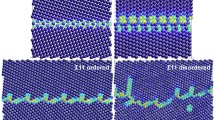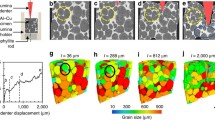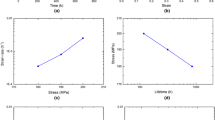Abstract
As a result of the extremely strong interatomic bonds, pores and cracks are difficult to form in metals. They seem unlikely to be created intrinsically by the normal mechanisms involved in the formation of a solid by solidification from liquid, or condensation from vapor phases, or probably, by lattice mechanisms in the solid state. It is proposed here that initiation sites for pores and cracks for most failures of metals can only be initiated from unbonded interfaces. Such unbonded defects are introduced into metals only via extrinsic (entrainment) mechanisms resulting from production processes, particularly melting and casting. Only entrained inclusions, particularly bifilms, have unbonded interfaces that can be opened to constitute Griffith cracks and can explain the initiation of macroscopic fracture and related microscopic processes, such as a decohesion between the second phases and a matrix. In the absence of entrained defects, metals would be predicted to fail in tension only either (1) at high stresses probably in excess of 20 GPa or (2) by ductile flow to the point of 100 pct reduction in area. Improved melting and casting processes giving freedom from entrained defects promise unprecedented performance and reliability of engineering metals.






Similar content being viewed by others
References
A.H. Cottrell: The Griffith Centenary Meeting, Institute of Materials, London, UK, 1993, pp. 4-15.
A.H. Cottrell: Proc. Roy. Soc. A, 1963, vol. 279, pp. 1-10.
P.F. Thomason: Ductile Fracture of Metals, Pergamon Press, Oxford, UK, 1990.
J.F. Knott: in Recent Advances in Fracture, R.K. Mahidhara, ed., TMS, Warrendale, PA, 1997.
J. Campbell: The Solidification of Metals, 1968, vol. 110, pp. 18-26.
J.C. Fisher: J. Appl. Phys., 1948, vol. 19, pp. 1062-67.
D. Kuhlmann-Wilsdorf: in Lattice Defects in Quenched Metals, Academic Press, New York, NY, 1965.
P. Moser, C. Corbel, P. Lucasson, and P. Hautojarvi: Mater. Sci. Forum, 1987, vols. 15–18, pp. 925–30.
A. Sen Gupta, P. Moser, A. Bourret, C. Corbel, S.V. Naidu, P. Sen, and P. Hautojarvi: Mater. Sci. Forum, 1987, vols. 15–18, pp. 931-36.
C. Hellio, C.H. de Novion, A. Marraud, L. Boulanger: Mater. Sci. Forum, 1987, vols. 15-18, pp. 937-42.
C. Weiberg and Y. Quere: Mater. Sci. Forum, 1987, vols. 15–18, pp. 943-48.
B.P. Uberuaga, R.G. Hoagland, S.M. Valone, and A.F. Voter: Phys. Rev. Lett., 2007, vol. 99, pp. 135501-3.
M.J. Sabochick, S. Yip, and N.Q. Lan: Mater. Sci. Forum, 1987, vols. 15–18, pp. 857-62.
S. Traiviratana, G.M. Bringa, D.J. Benson, and M.A. Meyers; Acta Mater., 2008, vol. 56, pp. 3874-86.
F. Milstein, J. Zhao, and D. Maroudas: Phys. Rev. B, 2004, vol. 70, 184102-1–184102-16.
M.A. Meyers, S. Traiviratana, V.A. Lubarda, D.J. Benson, and E.M. Bringa: JOM, 2009, vol. 61, no. 2, pp. 35-41.
J. Campbell: Mater. Sci. Technol., 2006, vol. 22, no. 2, pp. 127–45 and no. 8, pp. 999–1008.
D. Dispinar and J. Campbell: Mater. Sci. Eng. A, 2011, vol. 528, nos. 10–11, pp. 3860–65.
J. Campbell: Mater. Sci. Technol., 2011, in press.
J. Campbell: AFS Int. J. Metalcasting, 2008, vol. 2, no. 2, pp. 43-46.
J. Campbell: Mater. Sci. Technol., 2009, vol. 25, no. 1, pp. 125-26.
H. Sina, M. Emamy, M. Saremi, A. Keyvani, M. Mahta, and J. Campbell: Mater. Sci. Eng. A, 2006, vol. 431, pp. 263-76.
M. Emamy, R. Abbasi, S. Kaboli, and J. Campbell: Int. J. Cast Metals Res., 2009, vol. 22, no. 6, pp. 430-37.
J. Campbell: Materials, 2011, vol. 4 (7), pp. 1271–86.
M. Tiryakioglu, J. Campbell, and C. Nyahumwa: Metall. Mater. Trans. B, 2011, DOI:10.1007/s11663-011-9577-3.
J. Campbell and M. Tiryakioglu: Mater. Sci. Technol., 2010, vol. 26, no. 3, pp. 262-68.
J.T. Staley, M. Tiryakioglu, and J. Campbell: Shape Casting: The 2nd Int. Symp., P.N. Crepeau, M. Tiryakioglu, and J. Campbell, eds., TMS, Warrendale, PA, 2007, pp. 159–66; Mater. Sci. Eng. A, 2007, vols. 460–461, pp. 324–34 and vol. 465, pp. 136–45.
W.D. Griffith, R. Raiszadeh, and A.O. Omotunde: Shape Casting: The 2nd Int. Symp, P.N. Crepeau, M. Tiryakioglu, and J. Campbell, eds., TMS Warrendale, PA, 2007, pp. 35–42.
R.N. Lumley, T.B. Sercombe, and G.B. Schaffer: Metall. Mater. Trans. A, 1999, vol. 30A, pp. 457-63.
J. Campbell: Metall. Mater. Trans. A, 2009, vol. 40A, pp. 1009-10.
J. Campbell and M. Tiryakioglu: Trans. Am. Foundry Soc., 2011, vol. 115, pp. 11-127.
M. Tiryakioglu, J. Campbell, and J.T. Staley: Scripta Mater., 2003, vol. 49, pp. 873-78.
C.H. Caceres: Aluminum Trans., 1999, vol. 1, pp. 1-13.
M. Tiryakioglu: Ph.D. Dissertation, University of Birmingham, Birmingham, UK, 2002.
J. Griffith, E.C. Oliver, M.E. Fitzpatrick, T.R. Finlayson, D. Viano, and Q. Wang: Shape Casting: The 2nd Int. Symp, P.N. Crepeau, M. Tiryakioglu, and J. Campbell, eds., TMS, Warrendale, PA, 2007, pp. 127–34.
E. Orowan: Rep. Progr. Phys., 1948–1949, vol. 12, pp. 185–232.
A. Kelly: Strong Solids, Clarendon Press, Oxford, UK, 1966.
K. Gall, M.F. Horstemeyer, M. van Schilfgaarde, and M.I. Baskes: J. Mech. Phys. Solids. 2000. vol. 48. pp. 2183-2218.
R.K. Govila and D. Hull: Acta Metall., 1968, vol. 16, pp. 45-52.
M. Gernez: Phil. Mag., 1867, vol. 33, no. 4, pp. 79.
S. Mendelson: J. Appl. Phys., 1962, vol. 33, no. 7, pp. 2182-86.
M. Emamy and J. Campbell: Cast Metals, 1995, vol. 8, pp. 115-22.
P.W. Bridgeman: Studies in Large Plastic Flow and Fracture (with Special Emphasis on the Effects of Hydrostatic Pressure, McGraw-Hill, Columbus, OH, 1952, pp. 38-86.
J. Campbell: Casting Practice; The 10 Rules for Casting, Elsevier, Atlanta, GA, 2004.
Author information
Authors and Affiliations
Corresponding author
Additional information
Manuscript submitted July 7, 2011.
Rights and permissions
About this article
Cite this article
Campbell, J. The Origin of Griffith Cracks. Metall Mater Trans B 42, 1091–1097 (2011). https://doi.org/10.1007/s11663-011-9575-5
Published:
Issue Date:
DOI: https://doi.org/10.1007/s11663-011-9575-5




